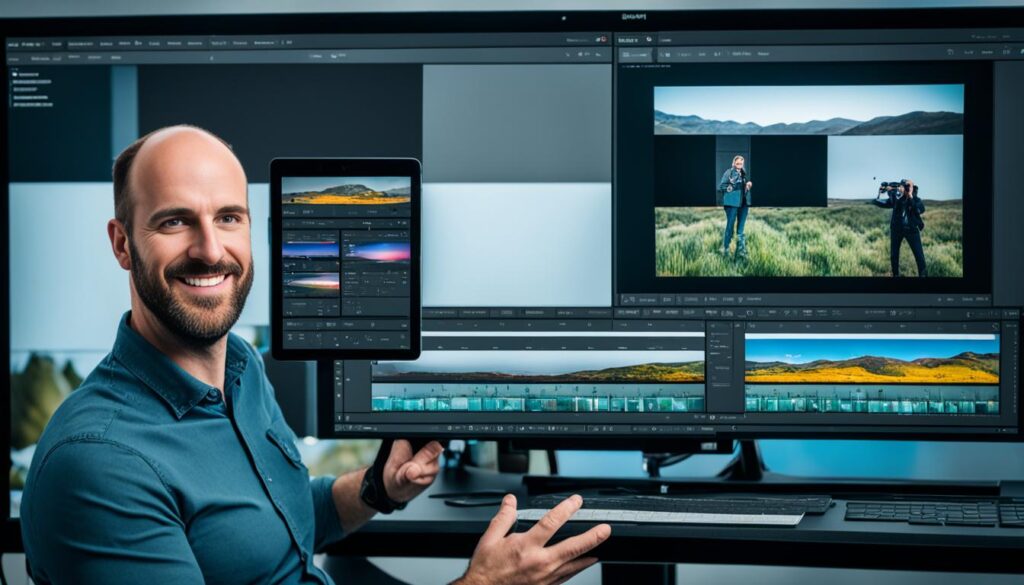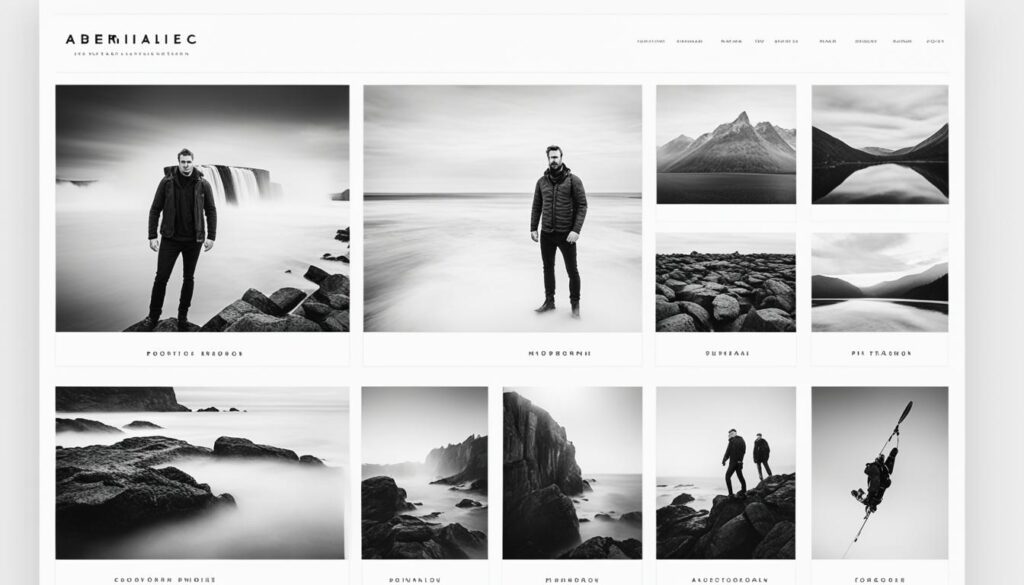From Pixels to Portfolios: Crafting Your Corporate Image Through Photography
Imagine walking by the bright shops on the high street. Each display is trying to catch your eye. Now, think of your company’s website as one of those windows. It can reach people all over the world. Here, taking the perfect corporate photo is critical. It’s your silent greeting in the digital world. In today’s age, a robust corporate image means having a solid online presence. Professional photographers play a considerable role. They don’t just take photos. They show what your company stands for through images, telling a story that fits your brand.
Your corporate photos and online galleries are crucial. They’re not just filling space on your website. They’re the first thing people notice. They capture everything from the right angles to the play of light. Each photo is a carefully crafted step towards perfection. It shows your commitment to quality and reflects your company values.
You’re doing more than just making pictures when adding photos to your collection. It’s about building an identity that speaks to everyone who sees it, including potential partners and clients. This is what makes professional photography so valuable. It goes beyond the ordinary, turning everyday moments into something unique and portraying the best of what you do.
Key Takeaways
- Professional photography is paramount in defining your corporate image and brand identity.
- A polished corporate portrait on your company’s website can speak volumes to potential clients.
- Every image in your online portfolio is a testament to your brand’s story and values.
- Corporate headshots are more than mere photographs; they are a cornerstone of your digital presence.
- Elevating your corporate imagery from pixels to perfection is vital for leaving a lasting, professional impression.
Understanding Your Brand’s Narrative and Visual Identity
Starting on the path to promote your brand means more than a simple idea. It requires a thorough exploration of the story that is the core of your being. This story does not just share your history; it builds a bond with your audience. To genuinely connect with those you aim to engage, your narrative must be part of your visual identity. This includes your graphic design, typography, and more.

Aligning Imagery with Brand Values and Messages
Ensuring that your brand’s images align perfectly with your values is crucial. Your visuals must match your core beliefs. This visual language silently communicates your brand’s ethos. Every detail should echo your narrative through the colours in your graphic design or typography fonts.
Defining Your Brand’s Unique Visual Language
Consistency is crucial for your brand’s recognition, and defining a unique visual language is key. The graphic design and typography you choose will link to your brand, embedding your story in people’s minds. This repetition and familiarity help your brand not only be recognized but also flourish among your audience.
The Importance of Brand Consistency in Photography
Photography goes beyond showing off your offerings; it captures your brand’s essence. Achieving brand consistency in photography requires careful planning and understanding. Every photo should reflect your brand’s style and story, enhancing recognizable features of your identity. By being consistent, you reassure customers of your brand’s professionalism and strengthen your message.
Design Elements That Elevate Your Corporate Photography
Having a solid photography portfolio requires mixing design elements well. This mix helps tell a brand’s visual story. Focus on composition, lighting, and editing to achieve a professional look. These elements come together to make top-notch images. They show off your skill and your brand’s identity.
Composition Techniques such as the Rule of Thirds
Good composition grabs attention. Using the rule of thirds makes photos balanced and exciting. It guides the viewer’s eye to the key parts of your image. Aligning subjects with these points boosts your photo’s impact. This strategy plays a big part in defining your portfolio.
The Role of Lighting in Shaping Perceptions
Lighting changes how people see your photos. It brings out textures, highlights features, and adds depth. Good lighting suggests your work is professional and polished. Whether you aim for drama or subtlety, lighting sets the mood of your corporate photos.
Post-Processing Tips for a Professional Finish
Post-processing gives your photos their final touches. This step lets you brighten colours, fix flaws, and add features that fit your brand’s look. Attention to detail is key to a professional finish. It makes your photos clear, consistent, and professional.
To show what careful editing achieves, look at this table of before-and-after scenarios:
| Before Post-Processing | After Post-Processing |
|---|---|
| Flat colour profile | Vibrant colour enhancement |
| Noticeable shadows | Balanced shadows and highlights |
| Imperfections in details | Retouched for pristine quality |
| Lack of contrast | Adjusted contrast for depth |
| Generic appeal | Tailored to the brand’s style |
Every part of making photos matters. But your hard work and precision make your portfolio stand out. Every photo is a chapter in your corporate story.
Building a Visual Story that Resonates with Your Audience
A visual story is key to a successful photography portfolio. It’s more than pretty pictures. It’s how they come together to touch and captivate viewers. Each image should link to tell your brand journey‘s story. This creates a powerful, unified tale that highlights what you offer uniquely.
Telling a story that grabs attention means doing more than snapping photos. It requires a deep understanding and careful arrangement of visuals. If you can craft a narrative that’s both lovely to look at and reflects your brand’s spirit, you’ll stand out online. This effort can strengthen client bonds and bring in new ones.

Storytelling with images gives photographers a powerful tool. A well-chosen set of photos can deeply communicate. They might showcase important moments, product brilliance, or the real essence of a service. The small details in each image and how they are arranged build a big, impactful brand story.
So, see each photo as a part of your visual narrative. Carefully choose and order pictures that resonate. They should logically explain your brand’s path. The best stories stay with us. Aim to make each viewer remember your work.
Implementing Strategy in Your Photography Portfolio Development
Starting the journey to craft a corporate image is both creative and strategic. This process ranges from brainstorming to achieving a cohesive portfolio. It tells your brand’s story effectively. It’s a step-by-step process demanding careful planning. This is based on a clear grasp of your aims and aesthetic goals.
The Journey from Concept to Execution
A strong concept serves as your strategy’s foundation. Yet, its real strength is in how well you carry it out. This step involves picking the right subjects, themes, and portfolio styles. Every decision should strengthen the brand image you want to project.
Turning Your Visuals into a Cohesive Portfolio
Creating a cohesive portfolio that connects with people is key to a striking corporate look. Keeping a uniform style, theme, and message strengthens your brand’s story and helps carve out your visual identity in a busy market. Check each photo’s impact on the portfolio development, ensuring it integrates well into the whole set.
| Concept Documentation | Visual Consistency | Brand Narrative Integration |
|---|---|---|
| Establish theme and mood | Aesthetic alignment across the portfolio | Stories that reflect brand values |
| Outline subject matter and composition | Recurring motifs and colour schemes | Imagery that speaks to brand vision |
| Plan for lighting and angle considerations | Uniform editing style for visual flow | Integrating visual elements within brand messaging |
Remember, a top corporate image isn’t just about top-notch photos. It’s about blending strategy, planning, and artistry. It’s a visually told narrative crafted with precision and curated tightly.
Investing in Quality: The Impact of High-Resolution Images
Investing in high-resolution images does more than buy a photo. It boosts your brand perception and strengthens your professional identity. This investment shows your dedication to excellence. It changes how potential clients see your business. Corporate photography is vital. It shows your brand’s detailed qualities aligned with your values and market offer.
Think about your business’s focus on detail. Your images should also show this commitment to quality. High-quality photos capture textures, colours, and details that normal photos often miss. They connect better with your audience, showing an accurate view of your offerings.

The table below shows the differences between standard and high-resolution photos for brand images:
| Aspect of Brand Imagery | Standard Photography | High-Resolution Photography |
|---|---|---|
| Detail and Texture Representation | Lacks depth and precision | Exceptional clarity, showing the finest details |
| Professional Impression | It may appear amateurish and unrefined | Conveys a strong, professional identity |
| Brand Perception | Potentially diminished due to lower image quality | Enhanced by visually compelling and crisp images |
| Use in Marketing Materials | Limitations in scalability and print quality | Flexibility in use across platforms and in print |
| Customer Engagement | Less likely to capture and hold attention | More likely to engage and retain customer interest |
Every pixel tells a part of your brand’s story. Choose high-resolution images to share your story compellingly. They’ll upgrade your standing and impress your audience lastingly.
Technology and Tools: Enhancing Your Photography with Advanced Software
In the photography world, efficiency and quality are critical. Using advanced software and tools is now essential for pros. These technologies improve your editing and help you stay competitive in the digital landscape. They also smoother your workflow and increase your productivity.
Advanced Editing Software like Adobe Lightroom
Adobe Lightroom improves photos by letting photographers refine their shots with great detail. This advanced software helps bring your vision to life, turning minor tweaks into extensive upgrades. Lightroom offers many features beyond simple fixes, allowing your visuals to meet your client’s needs precisely.

Streamlining Your Workflow: Tools for Efficiency
Being great at photography isn’t just about the art but also about efficiency. Using tools and software smartly cuts down on time-consuming tasks, giving you more time for the creative side of your photography services. It’s about working smarter, not more complex, and using technology to enhance project efficiency.
| Tool | Function | Impact on Workflow |
|---|---|---|
| Bulk Image Editing | Quickly apply adjustments to multiple photos | Enhances editing speed and consistency |
| Presets and Profiles | One-click application of saved settings | Streamlines achieving a signature look |
| Non-Destructive Editing | Edits that don’t overwrite original images | Encourages experimentation without risk |
| Synchronised Cataloguing | Accessibility of works-in-progress on multiple devices | Facilitates a flexible editing environment |
| Automated Backups | Safeguards edits and originals | Ensures data security and peace of mind |
Online Presence: Curating a Digital Portfolio that Attracts Clients
Your digital portfolio is key as a photography professional. It acts as your digital shop window, showing off your skills. A well-made and SEO-optimised portfolio helps clients find you through search engines, making you a go-to name for professional photography.

To make your portfolio stand out, apply SEO strategies specific to photography. Use keywords smoothly and design your site for people and search engine bots. Adding new projects regularly keeps your site fresh and tells search engines you’re active.
Creating an SEO-Friendly Photography Portfolio Website
It’s crucial to make your photography site SEO-friendly. This means optimising your site’s structure, speeding up pages, and thoughtfully adding metadata. These steps work nonstop to showcase your photography online.
Integrating Social Media to Broaden Reach
Using social media also boosts your online presence. Sites like Instagram, Facebook, and Pinterest are great for photographers wanting more viewers. Linking your portfolio with social media helps engage more people and raise your profile widely.
| Feature | Benefits |
|---|---|
| Responsive Design | Ensures compatibility across all devices, improving user experience and SEO rankings. |
| High-Quality Images | Displays your work in the best light and communicates your expertise in professional photography. |
| Integrated Blog | Keeps content fresh and audience engaged while providing more opportunities to rank in search engines. |
| Social Media Links | Encourages visitors to follow your work on different platforms, broadening your digital footprint. |
Remember, your digital portfolio is more than images; it tells the story of your skill and brand. With SEO-friendly content and social media, you’re not just reaching more people but building lasting connections. So, enhance your online presence and let your photography win hearts worldwide.
Enabling Monetization: Features that Turn Views into Revenue
Your talent in photography should be more than just pleasing to look at. It can also turn into a significant source of monetization. Your images can unlock different revenue streams with the right strategies and tools. Imagine having a virtual gallery. It shows off your work and uses e-commerce functionality for direct print sales. Think of every click as a potential sale, turning viewers into supporters.

Think about offering licensing information easily and securely. This makes it simple for publishers or advertisers to use your photos legally while you get paid. Also, consider starting subscription services. They can attract a special group of people eager to pay for unique content that’s hard to find elsewhere. Adding a booking system for workshops can also turn site visitors into keen students learning from you.
A strong SEO optimization plan is vital for any successful online business. It makes sure your photography gets noticed in a busy online world. Getting a high rank in search engine results can bring more people to your site. Also, having a responsive design makes your site work well on various devices. This improves the chances of turning visits into sales. Read below to discover key features for making money from your photography:
- E-commerce Storefront for Selling Prints
- Clear Licensing Options for Image Usage
- Exclusive Subscription Content
- Online Booking for Photography Workshops
- Comprehensive SEO Practices to Drive Website Traffic
- Responsive Website Design for Optimal Viewing on All Devices
Adding these features to your site isn’t just about making money. It’s about appreciating your work and creating a professional space for clients to connect with your brand. Each monetization element can be customized to match your unique style and meet your audience’s needs. You can engage with viewers, make sales, and teach through your site. Enjoy the benefits of having a digital portfolio. It is a public display of your work and a private market for your creations.
Conclusion
The art of photography is key in today’s branding world. It’s essential in creating a solid corporate image. Photographers use their skills to tell stories that leave a profound impact. This shows their flexibility and ability to share a brand’s message.
Your camera captures the heart of a company. It shows the importance of photography in the market today. Your visual works showcase your skills and how closely you and the company’s values align. They invite people to see the brand’s story through your eyes.
Your photography helps shape how people see a company. Each picture you take adds to a company’s image, making a lasting impression. By embracing digital opportunities, your photography becomes crucial in branding. It ensures your place in today’s digitally connected world.
FAQ’s
Q: What is the importance of professional photography in today’s digital age?
A: Professional photography is pivotal in crafting your corporate image and showcasing your work in today’s digital age. Visual content is crucial in captivating your audience and evoking emotions.
Q: How can photography help elevate your work as a graphic designer?
A: Photography allows graphic designers to showcase their best work and demonstrate versatility. A visually appealing portfolio with professional photoshoots can help showcase your skills to potential clients.
Q: Why should businesses invest in commercial photography for their brand image?
A: Commercial photography is essential for businesses to showcase their products, services, and brand image visually. High-quality images can enhance your website and captivate your target audience.
Q: How can corporate headshots contribute to a professional corporate image?
A: Corporate headshots play a pivotal role in portraying professionalism and authenticity. Having professional headshots can ensure that every team member’s unique perspective is showcased on the corporate website.
Q: What tools like graphic design can complement professional photography?
A: Graphic design tools like Adobe Photoshop and Illustrator can complement professional photography by enhancing and editing images to ensure they meet the brand’s visually appealing standards.
Q: Why is it essential to have a photographer for your corporate events?
A: Hiring a professional photographer for corporate events ensures that every moment is captured seamlessly. These images can showcase the event and promote future events to the audience.
Q: How can professional photography help in creating a strong brand image?
A: Professional photography helps create a visually cohesive brand image by ensuring that all visual content aligns with the brand’s values and captures the essence of the brand’s message.







